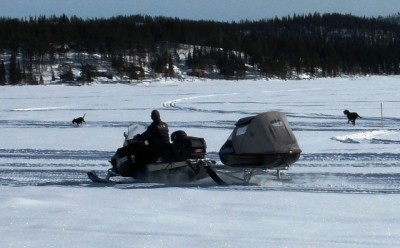We were a small audience in a village hall on the banks of the Lainio river, watching a performance of ‘Tosca’. At the close of the opera, Mario steps outside the prison to be shot. His lover has reassured him the executioner will use blanks and he just has to pretend to die.
It was ‘Tosca’ without the trimmings. The singers (who were really good) were accompanied by a piano – there was no orchestra. There was also no elaborate scenery. Instead, at the end of each act our chairs were moved so we faced a different direction and view. For the last act that view was the frozen river, white snow glimmering in both directions, with small dark fir trees lined up along the horizon and a mid-blue sky as a back drop.
Mario opened the door from the village hall to the river bank, and a cold wind blew around our legs in the third row. There was a gunshot, and Mario slumped through the doorway. Tosca was unable to rouse him, and, realising he really was dead, turned towards the river and shot herself. It couldn’t have been a more dramatic setting, and we didn’t miss the expensive extras people usually expect at the opera.
On the way home we had plenty of time to talk about what a good experience it had been. The road from the small village of Lainio is a very long one, a straight route through low pine and fir forest in a flat snow-covered landscape. You have plenty of time to think about ‘Tosca’ – you have space, as Thoreau has written, for your thoughts ‘to get into sailing trim and run a course or two before they get into port’.
You also have time to wonder why there’s a village in such an out of the way place.
It doesn’t take long to realise it wouldn’t have been thought of as out of the way when people first settled there (in the 17th century). What fools us is the road system. The current roads aren’t following ancient tracks – they’re much later additions. Finding your way through what was then ‘Lappland’ meant paddling a small boat up rivers, carrying it through rapids, and letting it drift through wide lakes. In the winter the route was passable on the ice, where the snow would be blown away and you could pull a sled behind you, or if you were Sami you would ski. Settlers in Lainio would have come in the summer by boat, and the reason they lived there was because it was a rich fishing river, and it was on a good route.
The day before we’d decided to go skiing and take a picnic out on the Torne river at Kurravaara, an area of houses which was a settlement long before Kiruna existed as a town. For the same reasons as Lainio, it was on a good route (the river) and provided fish all year round, and there was land there to live off. Now it’s a mixture of permanent housing – some people living there work in Kiruna – and what is called ‘summer’ housing, though this kind of temporary housing is used all year round.
It was the Thursday before the long Easter weekend and Kiruna had already started to empty. The Torne river is thick ice by this time of year and snow covered. Snow had fallen recently and hadn’t had time to harden, so we had to ski on the snowscooter tracks. I’m not a fan of snowscooters, but they do provide the service of pressing down the snow so it’s possible to walk or ski on it.
After an hour’s skiing we saw a rock to one side which we reckoned we could use to sit on and have some lunch. Making our way there through the trackless snow was heavy going, and removing the skis was a challenge because without them you sank deep into the snow. But we managed, and were feeling very hot sitting in the sun. The view of the river was spectacular, the sky so blue, and the air so still.
Still, that is, except for snowscooters whizzing by. We seemed to be at the junction of a major snowscooter highway. The noise and the smell carries quite a distance, and seems at odds with the tranquil setting. About every five minutes one went past us, most of them pulling substantial sleds carrying provisions for the coming weekend. It was entertaining to watch their dogs, tearing along the path beside them, or in most cases running far ahead, impatient with the slow progress of the snowscooter behind.

They were all heading the same way up river, where there are no roads but many small houses and huts. These would have been traditional settlements, long before Kiruna was built. The only way to reach them is snowscooter, or boat in the summer. At holiday times the old transport routes become alive again, and the new ones are abandoned.
Not all the traffic was disturbing. We saw, at a distance, other ski-ers, moving noiselessly and slowly along the river. We met one woman coming on skis towards us. We stopped to talk. We agreed it was hotter than expected, and we were wearing too many clothes. She described where she was staying – her ‘summer’ house by the river. It was always lovely to be here, she said. She used the skis to visit her daughter who had a house further down the river. Of course it had no electricity or running water, but she’d just bought a device for charging her mobile phone which made life easier.
Minus degrees, no water, and no indoor toilet. But, as we discovered in Lainio, worse things can happen to you by a frozen river.

